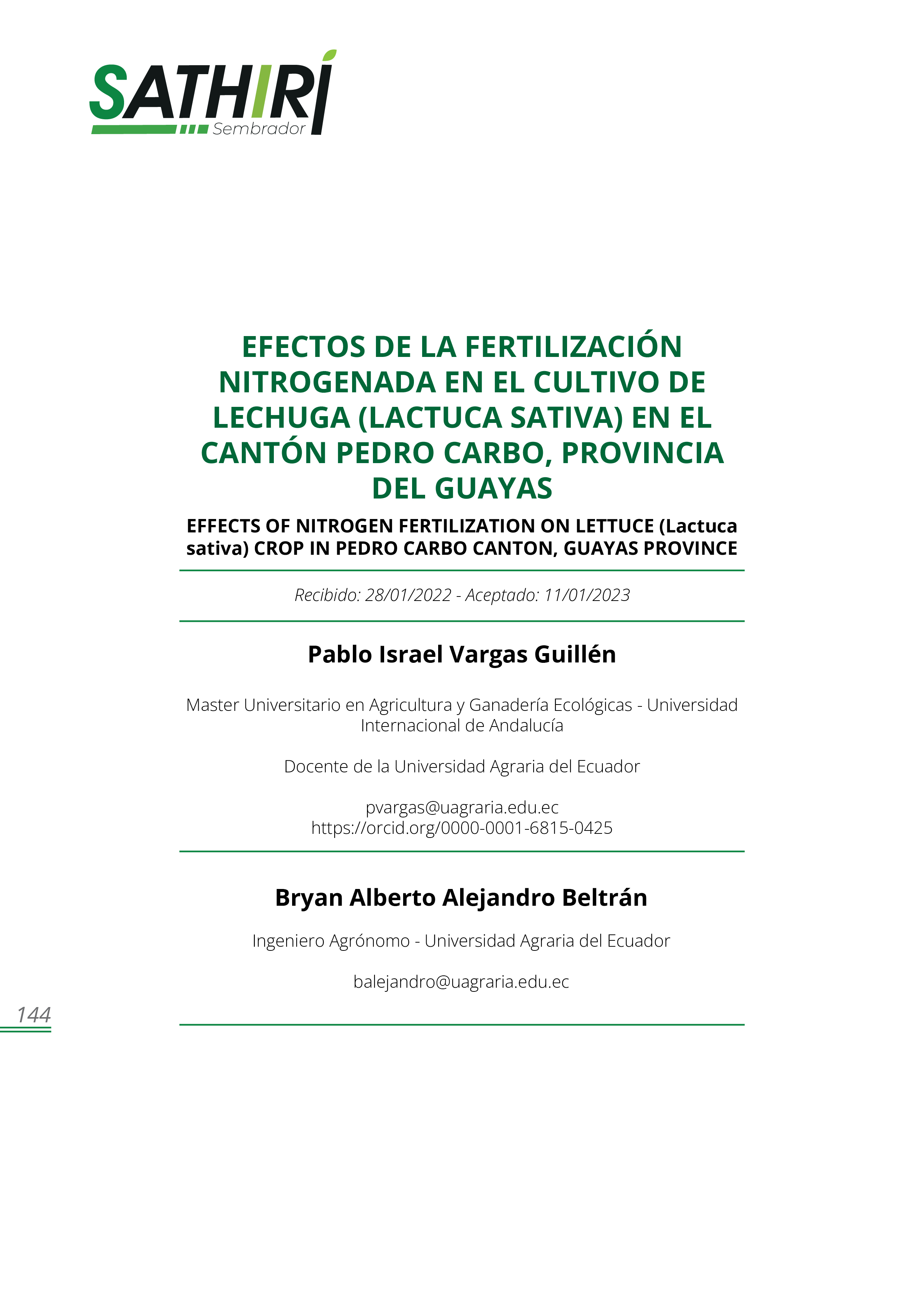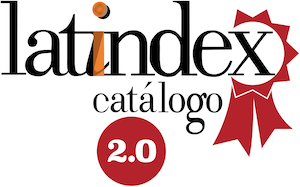Effects of nitrogen fertilization on lettuce (Lactuca sativa) crop in Pedro Carbo canton, Guayas province
DOI:
https://doi.org/10.32645/13906925.1196Keywords:
Fertilization, Lettuce, Nitrogenated, YieldAbstract
Nitrogen fertilization in lettuce cultivation complements the integral fertilization process, contributing to optimal and self-sustaining growth of the plant. The objective of this essay is to opt for nitrogenous fertilization alternatives that allow increasing the yield of the plant, for which different techniques and methodologies were applied, the same ones that were evaluated in their agronomic behavior, according to the study variables, contrasting these results with the economic analysis of the treatments under study through the Benefit-Cost relationship. In the development of the investigation, a completely randomized block design was used, evaluating three treatments: Treatment 1 (Urea), Treatment 2 (Micro-azot), Treatment 3 (Absolute Witness), replicated in five repetitions forming a total of fifteen experimental plots; each plot consists of nine square meters, in which the following were evaluated: plant height, days to harvest, diameter and number of commercial lettuces, lettuce weight (kg/plots), yield kg/ha, this being the most important variable , where it is concluded that the highest yield was obtained with the application of a nitrogenous fertilization (Urea). The best benefit/cost ratio resulted in treatment T1 (Urea) with 1.50 %, obtaining a net benefit of $3523.05, concluding that T1 (urea) is shown as the experiment that obtained the best results in the study zone; however, T1 and T2 do not present significant statistical differences, in contrast to T3; and with the exception of the variable "Days of harvest", in which said divergences were presented, between T1 and T2.
References
Aung, K., Jiang, Y. y He, S. Y. (2018). The role of water in plant in plant microbe Interaction. The Plant Journal, 93: 771-780
Baeta, S. A.; Kumar, F. N.; Stone, L. F. and Baeta, T. P. (2016). Effect of irrigation and nitrogen fertilization on the agronomic traits and yield of irrigated rice. Rev. Ceres, Vicosa. 63(5):724-731.
Bonomelli, C; Artacho, P; Maraboli, A. (2018). Factores fisiológicos a considerar en la fertilización nitrogenada del cerezo. Red Agrícola. Informe general. Pp1-5. Santiago.
Capetillo – Burela, A; Zetima – Lezama, R; Reynolds – Chávez, M; Ortega – Jiménez, E; López – Collado, C; Matilde – Hernánez, C (2021). Clasificación de suelos de riego cultivados con pasto Taiwán (Pennisetum purpureum) en Piedras Negras, Veracruz. In: Saynes-Santillán V., Fernández-Luqueño F., Ortiz-Monasterio-Rosas J. I. (Eds.). Uso Eficiente de Nitrógeno en la Agricultura. México. pp. 43 – 47.
Espinoza, J (2012). La urea y su comercialización en Chile. Informe. Oficina de Estudios y Políticas Agrarias. Ministerio de Agricultura. Gobierno de Chile.
FAOSTAT (2022). El sitio web de la base de datos estadísticos corporativos de la Organización para la Agricultura y la Alimentación. Cultivo y productos de ganadería. Producción/Rendimiento de lechuga y achicoria Ecuador. Consultado en línea y disponible en: https://www.fao.org/faostat/es/#data/QCL/visualize
EUROAGRO. (2019). Micro-azot. Bio fertilizante / fijador de Nitrógeno. Cuenca. Obtenido de http: https://studylib.es/doc/5577453/azotobacter-es-una-bacteria-cuya-principal-caracter%C3%ADstica.
García-Velázquez, L. y Gallardo, A. (2017). El ciclo global del nitrógeno. Una visión para el ecólogo terrestre.Revista Ecosistemas, 26 (1): 4-6.
Galloway, J. N.; Aber, J. D.; Erisman, J. W.; Seitzinger, S. P.; Howarth, R. W.; Cowling, E. B. and Cosby, B. J. (2003). The nitrogen cascade. BioSci. 53(4):341-356
Jaramillo, J; Aguilar, P; Tamayo, P. (2016) Modelo tecnológico para el cultivo de lechuga bajo buenas prácticas agrícolas en el oriente antioqueño. Recuperado de https://es.scribd.com/document/352080037/MANUAL-DEL-CULTIVO-DE-LALECHUGA
Lara – Izaguirre, Y; Rojas – Velásquez, A; romero – Méndez, M; Ramírez – Tobías, H; Cruz – Crespo, E; Alcalá – Jáuregui, J; Loredo – Ostí, C (2019). Crecimiento y acumulación de NO3 - en lechuga hidropónica con relaciones nitrato/amonio en dos estaciones de cultivo. Rev. Fitotec. Mex. Vol. 42 (1): 21 – 29. ISSN 0187-7380. México DF.
Marhuenda, J; García, J; (2015). Lechuga en Maroto, J y Baixauli, C (Eds.), Cultivos Hortícolas al aire libre (p. 239-270). Recuperado de https://es.scribd.com/document/359988473/Cultivos-Horticolas-Al-Aire-Libre-2
Morales – Morales, E; Rubí – Arriaga, M; López – Sandoval, J; Martínez – Campos, A; Morales – Rosales, E. (2019). Urea (NBPT) una alternativa en la fertilización nitrogenada de cultivos anuales. Revista Mexicana de Ciencias Agrícolas.
Morocho, M y Mora-Leiva, M. (2019). Microorganismos eficientes, propiedades funcionales y aplicaciones agrícolas. Revista Centro Agrícola. ISSN 0253-5785. Santa Clara
Pino, H. y Añez, B. (1997). Forma y tiempo de aplicación de nitrógeno en la producción de lechuga. Rev. Forest. Venezolana 41(1):87-88.
Reyes, A, y Soler, L. (2013). Efecto de la fertilización nitrogenada y de la materia órganica en el cultivo de lechuga (lactuca sativa l.) c.v. whithe boston improved. y las propiedades del suelo en condiciones de tapo – Huaribamba. Tesis de pregrado. Recuperado: http://repositorio.unh.edu.pe/handle/UNH/154.
Saavedra, G. (2017). Manual de producción de lechuga, Instituto de Investigaciones Agropecuarias (INIA). Santiago de Chile, Chile.
Saynes – Santillán, V; Fernández – Luqueño, F; Ortiz – Monasterio Rosas J. I (2021). Uso Eficiente de Nitrógeno en la Agricultura. (Eds.). CINVESTAT. México. Pp 205. ISBN. 978-607-9023-64-5
Schlesinger, H. W. (2009). On the fate of anthropogenic nitrogen. PNAS. 106(1):203-208.
Solís, P; Concepción, J; Carles, L; (2016): banco de Desarrollo Agropecuario. Manual de costos de producción y coeficientes pecuarios. Panamá. pp.60.
Tarigo, Repetto y Acosta (2004) Evaluación agronómica de biofertilizantes en la producción de Lechuga (Lactuca Sativa) a campo. Tesis de pregrado. Ingeniería agronómica. Universidad de la República de Uruguay. Montevideo. Recuperado de http://biblioteca.fagro.edu.uy/iah/textostesis/2004/3171tar1.pdf
Uribe, G., Dzib, R., (2016). Micorriza arbuscular (Glomus intraradices), Azospirillum brasilense y Brassinoesteroide en la producción de maíz en el suelo luvisol. Agric Téc, 32(1). Recuperado de la página web: http://www.scielo.org.mx/scielo.php?script=sci_arttext&pid=S0568-25172006000100007
Vega, A (2017). El efecto del nitrógeno en las enfermedades de las plantas. Informe. Universidad de Chile. Departamento de Ciencias Vegetales. Santiago. Pp. 33-35.
Velasco J., G. Aguirre y N. Ortuño (2016) Humus líquido y microorganismos para favorecer la producción de lechuga (Lactuca sativa var. Crespa) en cultivo de hidroponía. Journal of the Selva Andina Biosphere 4:71-83.
Velásquez, S. (2019). “Densidad de siembra en la producción de lechuga (Lactuca sativa l.) Cv. Angelina bajo condiciones de la Molina”. Tesis de grado. UNALM. Lima.
Vivian, Z.; Larsona, J. A.; Yinb, X.; Savoyc, H. J.; McClureb, A. M.; Essingtonc, M. E. and Boyera, Ch. N. (2018). Profitability of enhanced efficiency urea fertilizers in no-tillage corn production. Agron. J. Abs. - Crop Econ. Prod. Manag. 110(4):1439-1446.

Downloads
Published
Issue
Section
License
Copyright (c) 2023 Pablo Israel Vargas Guillén, Bryan Alberto Alejandro Beltrán, Paulo Humberto Centanaro Quiróz, Luzmila María Valverde Medina

This work is licensed under a Creative Commons Attribution-NonCommercial-NoDerivatives 4.0 International License.
El autor mantiene los derechos morales e intelectuales de su obra, autorizando a la editorial de la revista Sathiri la difusión y divulgación de su contenido con fines estrictamente académicos y de investigación, sin fines de lucro. Así mismo, se autoriza que la obra sea descargada y compartida con otras personas, siempre y cuando no sea alterada y se reconozca su autoria.





















